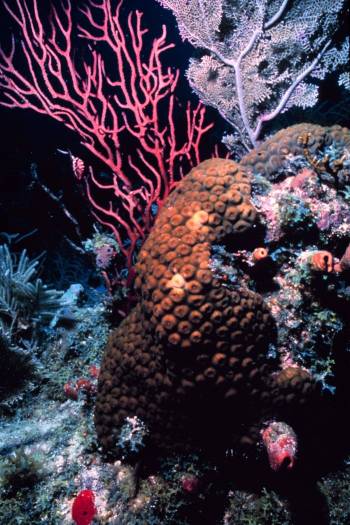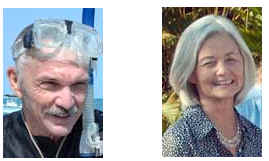
|
||||||||||||
|
|
Corals
Credit: Kevin Roland http://www.coral.org
Coral is a general term used to describe a group of cnidarians, which indicates the presence of skeletal material that is embedded in the living tissue or encloses the animal altogether. -National Oceanic and Atmospheric Administration, U.S. Dept. of Commerce. "Glossary of Coral Reef Terminology."
Credit: Chuck Savall http://www.coral.org
Corals themselves are tiny animals which belong to the group cnidaria (the "c" is silent). Other cnidarians include hydras, jellyfish, and sea anemones. Corals are sessile animals, meaning they are not mobile but stay fixed in one place.They feed by reaching out with tentacles to catch prey such as small fish and planktonic animals.
Photographer:
Mike White
Corals are anthozoans, the largest class of organisms within the phylum Cnidaria. Comprising over 6,000 known species, anthozoans also include sea fans, sea pansies and anemones. Stony corals (scleractinians) make up the largest order of anthozoans, and are the group primarily responsible for laying the foundations of, and building up, reef structures. For the most part, scleractinians are colonial organisms composed of hundreds to hundreds of thousands of individuals, called polyps.
Most corals are made up of hundreds of thousands individual polyps like this one. Many stony coral polyps range in size from one to three millimeters in diameter. Anatomically simple organisms, much of the polyp’s body is taken up by a stomach filled with digestive filaments. Open at only one end, the polyp takes in food and expels waste through its mouth. A ring of tentacles surrounding the mouth aids in capturing food, expelling waste and clearing away debris. Most food is captured with the help of special stinging cells called nematocysts which are inside the polyp' outer tissues, which is called the epidermis. Calcium carbonate is secreted by reef-building polyps and forms a protective cup called a calyx within which the polyps sits. The base of the calyx upon which the polyp sits is called the basal plate. The walls surrounding the calyx are called the theca. The coenosarc is a thin band of living tissue that connect individual polyps to one another and help make it a colonial organism. As members of the phylum Cnidaria, corals have only a limited degree of organ development. Each polyp consists of three basic tissue layers: an outer epidermis, an inner layer of cells lining the gastrovascular cavity which acts as an internal space for digestion, and a layer called the mesoglea in between
All coral polyps share two basic structural features with other members of their phylum. The first is a gastrovascular cavity that opens at only one end. At the opening to this cavity, commonly called the mouth, food is consumed and some waste products are expelled. A second feature all corals possess is a circle of tentacles, extensions of the body wall that surround the mouth. Tentacles help the coral to capture and ingest plankton for food, clear away debris from the mouth, and act as the animal’s primary means of defense.
coral polyps While coral polyps have structurally simple body plans, they possess several distinctive cellular structures. One of these is called a cnidocyte—a type of cell unique to, and characteristic of, all cnidarians. Found throughout the tentacles and epidermis, cnidocytes contain organelles called cnidae, which include nematocysts, a type of stinging cell. Because nematocytes are capable of delivering powerful, often lethal toxins, they are essential to capturing prey, and facilitate coralline agonistic interactions Most corals, like other cnidarians, contain a symbiotic algae called zooxanthellae, within their gastrodermal cells. The coral provides the algae with a protected environment and the compounds necessary for photosynthesis. These include carbon dioxide, produced by coral respiration, and inorganic nutrients such as nitrates, and phosphates, which are metabolic waste products of the coral. In return, the algae produce oxygen and help the coral to remove wastes. Most importantly, they supply the coral with organic products of photosynthesis. These compounds, including glucose, glycerol, and amino acids, are utilized by the coral as building blocks in the manufacture of proteins, fats, and carbohydrates, as well as the synthesis of calcium carbonate (CaCO3). The mutual exchange of algal photosynthates and cnidarian metabolites is the key to the prodigious biological productivity and limestone-secreting capacity of reef building corals.
Zooxanthellae (Courtesy Scott R. Santos, of the State University of New York at Buffalo) Zooxanthellae often are critical elements in the continuing health of reef-building corals. As much as 90% of the organic material they manufacture photosynthetically is transferred to the host coral tissue . If these algal cells are expelled by the polyps, which can occur if the colony undergoes prolonged physiological stress, the host may die shortly afterwards. The symbiotic zooxanthellae also confers its color to the polyp. If the zooxanthellae are expelled, the colony takes on a stark white appearance, which is commonly described as “coral bleaching”
Tropical coral reefs can be found
in a zone between 30° north and 30° south of the equator. They don't grow
deeper than 50 meters and the optimum water temperature is 25-27°C degrees,
with some species able to live in colder waters up to 18°C.
Cold water corals live in higher latitudes as deep as 2000 meters and with water temperatures 4°C. These corals are stony corals but they don't necessary host a zooxanthella. Deep water corals don't form reefs but they form aggregation called banks or bioherms. Deep sea corals also referred to as mounds, which describes the calcium carbonate skeleton which left behind as the coral grows.
Cold water corals live in nutrient rich water and feed on zooplankton. They
are also form a diverse ecosystem hosting fish species and invertebrates.
These corals are much more vulnerable as they grow slower and takes more
time to recover. They mainly threatened by human activity such as trawling
and long line fishing. Also laying of submarine communication cables can
cause huge damage.
Reef Relief founders Craig and DeeVon Quirolo retired from the grassroots organization last July, only to begin an effort to provide an online resource on coral reefs. Their new website provides all the award-winning educational tools, grassroots strategies, project reports and images of coral reefs assembled during their work over the past 23 years in the Florida Keys and throughout the Caribbean protecting coral reefs. You can find it at www.reefrelieffounders.com
credit: NOAA, NASA, Reef Check, UNEP, Reef Relief, Australian Government, University of Texas, Great Barrier Reef Marine Park Authority, Coral Reef Alliance |


















